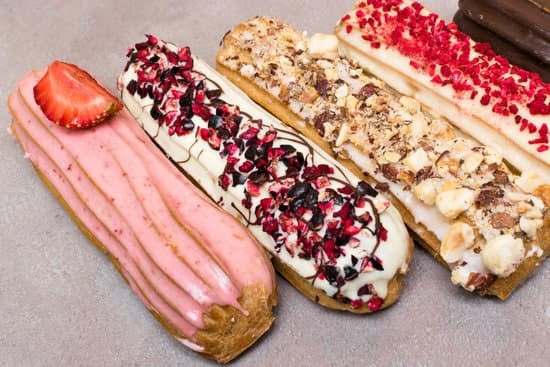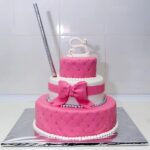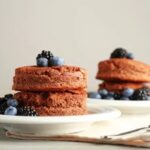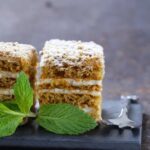Welcome to the world of professional cake decorating. In this comprehensive guide, we will take a closer look at Units 7-9 of the Cake Decorating Manual.
These units are designed to help you explore advanced techniques and designs in cake decorating, taking your skills to the next level. Whether you are a seasoned professional or just starting out on your baking journey, these units will provide you with valuable knowledge and inspiration to create stunning cakes that leave lasting impressions.
Unit 7 focuses on mastering the art of fondant, providing you with techniques and tips to achieve flawless finishes and intricate designs. Unit 8 takes a deep dive into creating beautiful sugar flowers, guiding you step-by-step through the process. Finally, Unit 9 pushes the limits of sculpted cakes, uncovering methods that allow your creativity to soar.
Throughout these units, you will also gain insights into perfecting piping techniques, exploring edible 3D designs, incorporating airbrushing techniques and troubleshooting common challenges in cake decorating. With each chapter offering unique skills and strategies, these units are sure to equip you with an extensive toolkit for elevating your cake designs.
So whether you are a professional baker looking to expand your repertoire or an ambitious home baker ready to take on more advanced projects, join us as we delve into Cake Decorating Manual Units 7-9. From fondant mastery to intricate sugar flowers and beyond, get ready to unleash your artistic skills and create showstopping cakes that captivate both eyes and taste buds.
Overview of Units 7-9
Units 7-9 in the Cake Decorating Manual delve into the world of advanced techniques and designs, offering professional bakers the opportunity to take their skills to new heights. These units are designed to challenge and inspire, allowing decorators to experiment with a wide range of techniques and expand their creative possibilities. In this section, we will provide an overview of what you can expect from Units 7-9 in the Cake Decorating Manual.
Unit 7 focuses on mastering the art of fondant. Fondant is a versatile medium that allows for intricate designs and smooth finishes on cakes. This unit will teach you various techniques for working with fondant, including rolling it out smoothly, covering cakes with precision, creating detailed patterns or designs, and achieving flawless finishes. You’ll also learn tips and tricks for troubleshooting common issues that may arise when working with fondant.
Unit 8 explores the world of sugar flowers. In this unit, you will learn how to create beautiful and realistic sugar flowers that can take your cake designs to another level. From delicate roses to vibrant peonies, this step-by-step tutorial will guide you through the process of crafting these intricate floral decorations using different types of tools and materials. You’ll gain valuable insight into color mixing, petal shaping, assembly techniques, and arranging these sugar flowers on cakes.
Unit 9 is all about pushing the limits of sculpted cakes. If you’re looking to unleash your creativity and create showstopping cake designs that amaze your customers, this unit is for you. You’ll learn advanced sculpting techniques using different tools and materials like modeling chocolate or rice cereal treats. This unit also covers how to incorporate structural supports ensuring your sculpted creations stay intact throughout transport or events.
Mastering the Art of Fondant
Fondant is a versatile and popular medium for cake decorating, known for its smooth finish and ability to create intricate designs. In Units 7-9 of the Cake Decorating Manual, bakers are introduced to advanced techniques and tips for mastering the art of fondant.
One of the first techniques covered in these units is how to properly cover a cake with fondant. Bakers will learn how to roll out the fondant to an even thickness, ensuring it is large enough to cover the entire cake. The manual provides step-by-step instructions on how to drape the fondant over the cake and smooth out any wrinkles or air bubbles for a flawless finish.
In addition to covering cakes, bakers will also learn various ways to use fondant for embellishments and decorations. From creating delicate ruffles and pleats to sculpting intricate figurines and characters, the Cake Decorating Manual offers comprehensive tutorials that cater to both beginner and experienced decorators. Bakers can explore techniques such as embossing, quilting, and stenciling with fondant to add texture and dimension to their creations.
To assist bakers in mastering the art of fondant, Units 7-9 also provide valuable tips for troubleshooting common challenges. For example, if the fondant becomes too sticky or tears easily, bakers can refer to the manual for guidance on incorporating additional powdered sugar or kneading techniques that can help salvage the situation.
With these advanced techniques and tips from Units 7-9 of the Cake Decorating Manual, bakers are equipped with all they need to elevate their skills and create stunning cakes using fondant. Whether it’s a wedding cake adorned with delicate lace patterns or a whimsical birthday cake featuring whimsical figures, mastering this art form opens up endless possibilities for creativity and personal expression.
Elevating Cake Designs with Intricate Sugar Flowers
In Units 7-9 of the Cake Decorating Manual, professional bakers will have the opportunity to explore and master advanced techniques in cake decorating. One of the most visually stunning techniques covered in these units is the art of creating intricate sugar flowers. These delicate and lifelike floral decorations can truly elevate any cake design, adding elegance and beauty.
To create these stunning sugar flowers, it is important to start with the right tools and materials. In Units 7-9, you will learn about the essential equipment needed such as flower cutters, veiners, and shaping tools. Additionally, it is crucial to use high-quality gum paste or fondant mixed with a tylose powder for durability and flexibility.
The step-by-step tutorial provided in the Cake Decorating Manual Units 7-9 will guide you through the process of creating sugar flowers from start to finish. It begins with preparing the gum paste or fondant mixture and coloring it as desired. Then, you will be taught how to roll out the dough to an even thickness and using various cutters to create flower petals.
The next step involves using veiners to add texture and detail to each petal. Finally, you will learn how to assemble the petals into beautiful blossoms and attach them to your cake.
| Equipment | Materials |
|---|---|
| Flower cutters | Gum paste or fondant |
| Veiners | Tylose powder |
| Shaping tools | Food coloring |
By following the detailed instructions and practicing these techniques, you will be able to create gorgeous sugar flowers that will impress your customers and elevate your cake designs. Whether you are a professional baker looking to expand your repertoire or an enthusiast eager to learn new skills, Units 7-9 of the Cake Decorating Manual will provide you with all the knowledge and guidance you need to master the art of creating intricate sugar flowers. Happy decorating.
Pushing the Limits of Sculpted Cakes
The Beauty of Sculpted Cakes
One of the most exciting and visually stunning aspects of cake decorating is the art of sculpting cakes. With techniques learned from Units 7-9 of the Cake Decorating Manual, bakers can truly push the limits of their creativity and create show-stopping designs that are as delicious as they are beautiful. Sculpted cakes allow bakers to think outside the traditional cake shape and create unique, eye-catching designs that will wow their customers.
Techniques for Sculpting Cakes
In Units 7-9, bakers will learn a wide range of techniques for sculpting cakes. They will discover how to carve cakes into various shapes, such as animals, vehicles, or even objects like handbags or books. Bakers will also dive into the world of structural support and learn how to properly construct a stable base for their sculpted creations.
Additionally, Units 7-9 will cover methods for adding intricate details to sculpted cakes. Bakers will explore techniques such as modeling chocolate or fondant accents, using edible paints or dusts to add depth and dimension, and creating texture with buttercream or royal icing. With these techniques at their disposal, bakers can take their sculpted cakes to a whole new level.
Unleashing Your Creativity
When it comes to sculpted cakes, the possibilities are truly endless. Units 7-9 encourage bakers to unleash their creativity and think outside the box when designing these edible works of art. Bakers will learn how to sketch out their ideas before sculpting, allowing them to visualize the final product and make necessary adjustments along the way.
By pushing the limits of what can be done with cake sculpting techniques from Units 7-9, bakers can create truly jaw-dropping designs that leave a lasting impression on both taste buds and eyes. Whether it’s a lifelike animal, a whimsical character, or an abstract sculpture, sculpted cakes are sure to be the centerpiece of any celebration.
With the knowledge and skills gained from Units 7-9 of the Cake Decorating Manual, bakers can confidently explore the world of sculpted cakes and unleash their creativity with every slice. So go ahead, let your imagination run wild and create edible masterpieces that will astonish and delight your customers. Happy cake sculpting.
Perfecting Piping
Piping is a fundamental cake decorating technique that allows bakers to create intricate designs and patterns on their cakes. In Units 7-9 of the Cake Decorating Manual, professional bakers have the opportunity to explore advanced piping techniques that take their skills to the next level. This section will delve into some of these techniques and reveal the secrets behind perfecting piping.
Introduction to Advanced Piping Techniques
In Units 7-9, bakers will learn how to elevate their piping skills by mastering more complex techniques. From delicate lacework to intricate brush embroidery, these units provide a comprehensive guide to creating stunning piped designs on cakes. Bakers will also be introduced to advanced tools and materials that can enhance their piping work, such as specialized piping tips and stencils.
Creating Beautiful Details with Royal Icing
Royal icing is a versatile medium that bakers can use for piping intricate details on cakes. In Units 7-9, professionals will learn how to make the perfect royal icing consistency and practice different types of piping, including filigree work, stringwork, and extension work. Bakers will also discover tips for achieving smooth lines and sharp edges when using royal icing.
Mastering Multi-Colored Piping
Units 7-9 also delve into the art of multi-colored piping, where bakers can create vibrant designs by using multiple colors in a single piping bag or by utilizing two separate bags simultaneously. Professionals will learn various techniques for blending colors seamlessly and creating visually striking effects through controlled hand movements.
By studying Units 7-9 of the Cake Decorating Manual, bakers can refine their pipe-work skills and expand their repertoire of decorative techniques. From advanced royal icing details to multi-colored piping tricks, these units are designed to unleash creativity and take cake decorating to new heights. With practice and dedication, bakers can perfect their piping techniques and create show-stopping designs that will impress their customers.
Exploring Edible 3D Designs
In Units 7-9 of the Cake Decorating Manual, professional bakers have the opportunity to dive into the exciting world of edible 3D designs. This section will explore the insider tips and tricks that will wow your customers and take your cake decorating skills to new heights.
One of the key techniques taught in Units 7-9 is creating realistic and eye-catching sculpted cakes. This involves shaping and carving cake layers into intricate designs such as animals, vehicles, or even buildings.
The manual provides step-by-step tutorials on how to achieve these impressive creations, including guidance on structuring the cake for stability and using fondant or modeling chocolate for seamless finishes. By exploring these units, you’ll learn how to transform a simple cake into a work of art that will leave your customers amazed.
Another aspect covered in Units 7-9 is incorporating advanced airbrushing techniques to enhance your cake designs. Airbrushing allows you to create gradients, shadows, and highlights with edible food coloring quickly and effortlessly. The manual goes into detail about how to use stencils, masking techniques, and layering colors effectively. By mastering this skill, you’ll be able to add depth and dimension to your cakes like never before.
Lastly, the Cake Decorating Manual addresses common challenges that arise when working with edible 3D designs. From structurally unsound sculptures to issues with colors bleeding or fading over time, these units provide valuable lessons and solutions for troubleshooting any problems that may occur during the advanced cake decorating process.
Exploring edible 3D designs in Units 7-9 of the Cake Decorating Manual not only allows you to unleash your creativity but also provides you with valuable tools and knowledge to impress your customers. So if you’re ready to take your cake decorating skills up a notch and create show-stopping designs that will leave everyone amazed, these units are an essential resource for any professional baker looking to elevate their craft.
Incorporating Airbrushing Techniques
Airbrushing is a powerful technique that can take your cake designs to the next level. In Units 7-9 of the Cake Decorating Manual, we delve into the art of airbrushing and provide you with the tools and knowledge to enhance your cake designs. Whether you are a professional baker or a hobbyist looking to expand your skills, incorporating airbrushing techniques can add depth, texture, and dimension to your creations.
One of the key benefits of airbrushing is its ability to create smooth gradients and transitions in colors. By using an airbrush tool with food-grade liquid colorings, you can achieve stunning ombre effects or seamlessly blend different hues together.
The manual covers various techniques for achieving these effects, such as using stencils for precise patterns or freehand spraying for more organic designs. Additionally, it offers tips on controlling the pressure and angle of the airbrush to achieve different levels of intensity and coverage.
In addition to creating smooth color blends, airbrushing also allows you to add intricate details and textures to your cake designs. With specialized stencils and masks, you can create patterns like lace or nature-inspired motifs effortlessly.
The manual provides step-by-step tutorials on how to use these stencils effectively and how to layer different patterns for a truly unique look. Furthermore, it explores techniques for creating texture with airbrushing, such as adding realistic texture to fondant or creating the illusion of depth in sculpted cakes.
By incorporating airbrushing techniques from Units 7-9 of the Cake Decorating Manual, you have the opportunity to elevate your cake designs and stand out from the crowd. Whether you want to create stunning gradients, add intricate details, or experiment with textures, airbrushing offers endless possibilities for unleashing your creativity. With practice and guidance from this comprehensive guide, you can master the art of airbrushing and create cakes that leave a lasting impression.
Troubleshooting Common Challenges in Cake Decorating
Cake decorating can be a challenging art form, and sometimes things don’t go as planned. In Units 7-9 of the Cake Decorating Manual, you will learn how to troubleshoot some common challenges that may arise during the cake decorating process. This section will provide you with valuable lessons and solutions to help you overcome these obstacles and create stunning cakes.
One common challenge in cake decorating is achieving smooth icing or fondant coverage without any imperfections. Sometimes air bubbles or wrinkles can appear on the surface, leaving an uneven finish. To fix this issue, make sure to thoroughly smooth out your icing or fondant using a smoother tool, starting from the center and working towards the edges. You can also try using a steamer to gently heat and smooth out any wrinkles.
Another challenge you may encounter is piping intricate designs with precision. It can be difficult to maintain consistent pressure while piping, resulting in inconsistent lines or blobs of icing. To overcome this challenge, practice piping techniques on parchment paper before applying them to your cake. This will give you a chance to perfect your technique and steady your hand before working on the actual cake.
Additionally, sculpted cakes can present unique challenges due to their unconventional shapes and structures. One common problem is stability issues, where layers may slide or topple over. To prevent this, use dowels or supports between layers to secure the structure of your cake. It’s also important to carve your cake carefully and evenly so that it remains stable throughout the decorating process.
| Common Challenge | Solution |
|---|---|
| Air bubbles or wrinkles on icing/fondant | Thoroughly smooth out with a smoother tool; use a steamer for wrinkles |
| Inconsistent piping lines/blobs of icing | Practice piping on parchment paper; steady your hand and apply consistent pressure |
| Stability issues with sculpted cakes | Use dowels or supports between layers; carve cake evenly for stability |
By learning how to troubleshoot these common challenges, you will be better equipped to tackle any obstacles that may come your way during the cake decorating process. Units 7-9 of the Cake Decorating Manual provide valuable lessons and solutions to help you overcome these challenges and elevate your cake decorating skills. With practice and perseverance, you can create stunning cakes that will impress your customers and showcase your artistic talents.
Conclusion
In conclusion, the Cake Decorating Manual Units 7-9 is a comprehensive guide that empowers professional bakers to take their skills to the next level. From mastering the art of fondant to creating intricate sugar flowers, this manual explores advanced techniques and designs that elevate cake decorating to an art form.
One of the highlights of Units 7-9 is the in-depth focus on fondant. By providing techniques and tips, this section enables bakers to perfect their fondant creations. Whether it’s covering an entire cake or creating intricate details, the manual equips bakers with the knowledge and skills needed to work with fondant confidently.
Another aspect that sets Units 7-9 apart is its step-by-step tutorial on sculpted cakes. By pushing the limits and unleashing creativity, bakers can create stunning sculpted cakes that impress customers and captivate audiences. With detailed instructions and guidance, this section encourages bakers to think outside the box and explore new dimensions in cake design.
Moreover, Units 7-9 also delves into advanced piping techniques that truly enhance cake designs. Perfecting piping skills takes practice and precision, but with insider tips from this manual, bakers can elevate their designs with intricate piping patterns and flawless finishing touches.
Furthermore, exploring edible 3D designs opens up a world of possibilities for cake decorators. Units 7-9 provides valuable insights and insider tricks to create jaw-dropping edible sculptures that will astonish customers and leave a lasting impression.
Incorporating airbrushing techniques also marks another milestone in Units 7-9. By learning how to enhance cake designs with airbrushing, bakers can bring their creations to life with vibrant colors that blend seamlessly.
Lastly, troubleshooting common challenges in cake decorating is crucial for every baker’s journey towards mastery. The lessons and solutions offered in Units 7-9 help overcome obstacles faced in the creative process, ensuring that every cake decorator can produce flawless creations.
Frequently Asked Questions
What are the levels of cake decorating?
Cake decorating can be broken down into several levels, each representing different skill sets and techniques. At the beginner level, individuals learn the basics of cake baking, leveling, and stacking layers, as well as simple buttercream frosting techniques such as piping borders or basic rosettes. Intermediate decorators move on to more advanced piping skills like creating intricate designs using various tips and mastering new frosting techniques like ombre or ruffles.
The advanced level involves complex techniques such as fondant work, sculpting 3D figures or objects, and intricate sugar flower arrangements. Expert cake decorators have perfected their skills over years of practice and are able to create awe-inspiring masterpieces that push the boundaries of creativity.
How do you transfer a design onto a cake?
Transferring a design onto a cake involves a few different methods depending on personal preference or the complexity of the design itself. One common technique is using a stencil, which can be made from plastic sheets or paper. The stencil is placed on top of the icing-covered cake, and using an offset spatula or palette knife, the desired buttercream colors are spread over specific areas of the stencil to create the design.
Another method is utilizing edible image printing technology where an image is printed onto edible paper using food-grade ink. The image is carefully transferred onto the surface of the frosted cake by applying gentle pressure with hands or a soft tool. For more intricate designs, some experienced decorators may use freehand drawing directly onto the cake with edible markers or food coloring pens.
How do you judge cake decorating?
Judging cake decorating requires expertise in assessing certain key elements that contribute to a well-decorated cake. Firstly, judges evaluate evenness in layering and stacking to ensure a visually pleasing structure without any imperfections like uneven layers or collapsed sides. They then examine icing application for smoothness and uniformity since any bumps, air bubbles, or uneven consistency can negatively impact aesthetics.
Attention to detail in decoration plays a vital role as judges inspect the neatness and precision of piping work, sculpted figures, or sugar flower arrangements. Artistic creativity and originality are also valued, as decorators who think outside the box and create unique designs often receive high marks. Lastly, judges assess color choices, balance, and overall visual appeal of the cake to determine its overall aesthetic impact.

Welcome to our cake decorating blog! My name is Destiny Flores, and I am the proud owner of a cake decorating business named Cake Karma. Our mission is to provide delicious, beautiful cakes for all occasions. We specialize in creating custom cakes that are tailored specifically to each customer’s individual needs and tastes.





